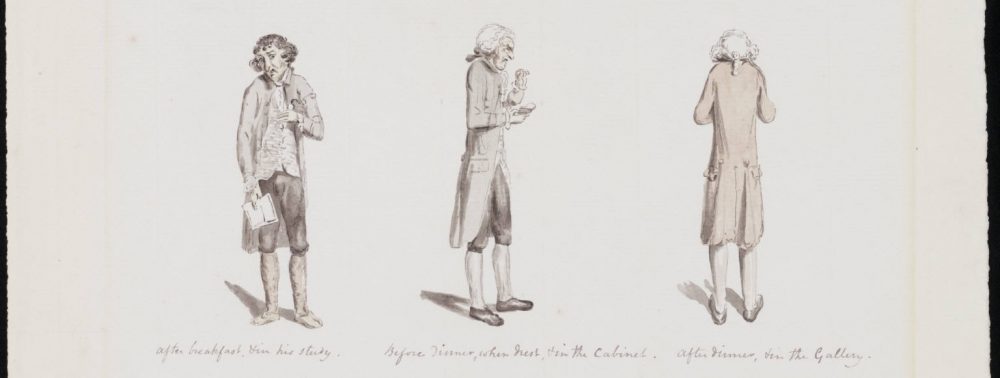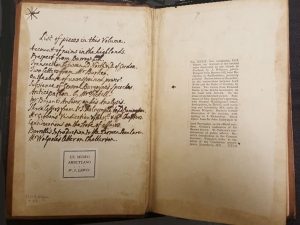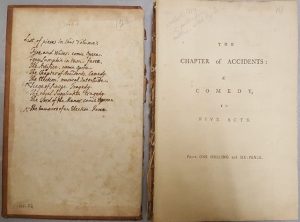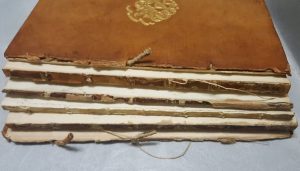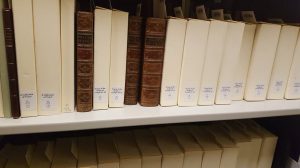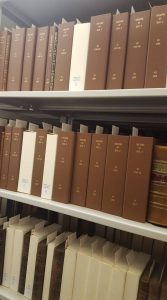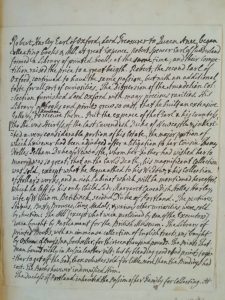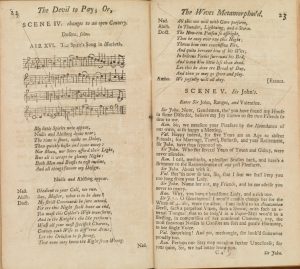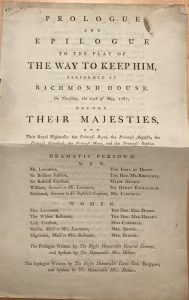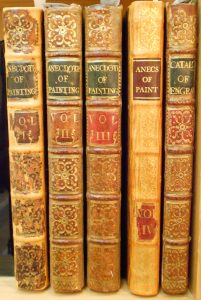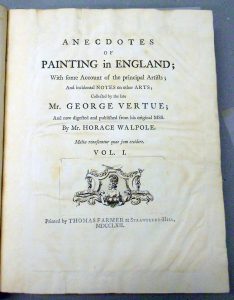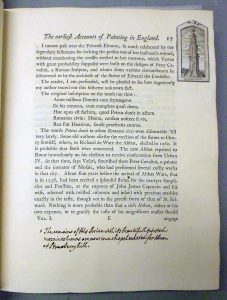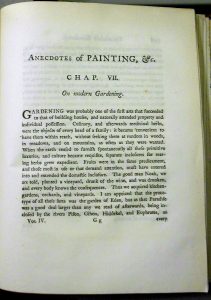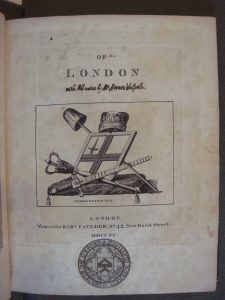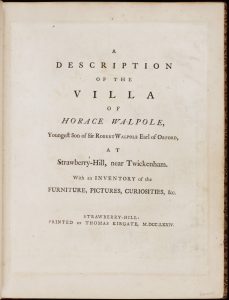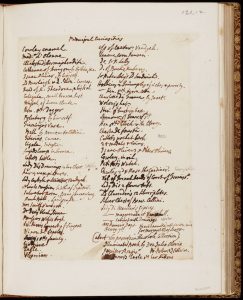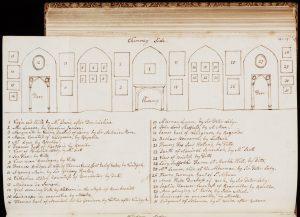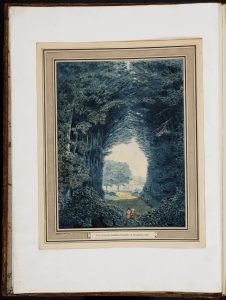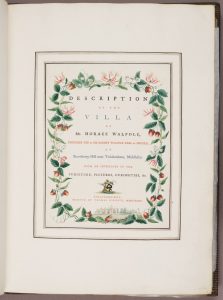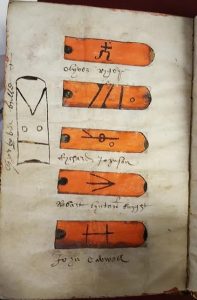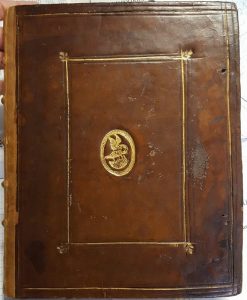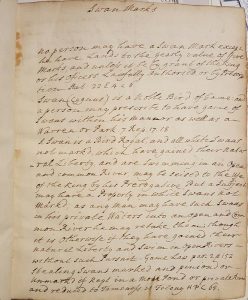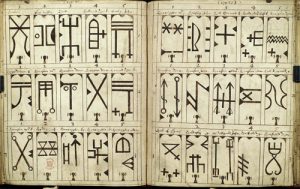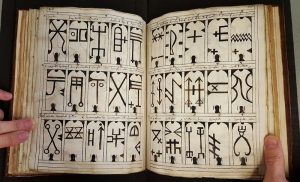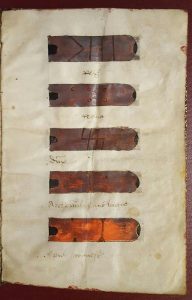23. Choice 13: “Tracts of the Reign of George 3”
By Wilmarth S. Lewis
“That is the title Walpole gave these 59 volumes. By ‘tract’ he meant the second definition of the word in the OED, ‘A book or written work treating of some particular topic; a treatise.’ He collected 335 of them for this collection; 224 in fifty-four octavo volumes, five with 111 tracts in quarto. All are bound in calf with Walpole’s arms on the sides and elaborately tooled spines labelled ‘Tracts of Geo. 3.‘ The earlier volumes have title-pages printed at the Strawberry Hill Press, ‘A Collection of the most remarkable TRACTS/Published/in the REIGN/of/King George the third,’ and all have a ‘List of Pieces in this Volume’ written on the inside of the front covers in Walpole’s clearest hand. He frequently added the month below the year on the title-page and the names of anonymous authors; throughout are his crosses, short dashes, exclamation points, and, rarely, an asterisk. I bought the collection from the estate of Sir Leicester Harmsworth in 1938.
“Its variety appears in volume 39:
“Williams, John. An Account of some remarkable ancient ruins, lately discovered in the Highlands, 1777.
“Junus, pseud. A serious letter to the public, on the late transaction between Lord North and the Duke of Gordon, 1778.
“Burke, Edmund. Two letters from Mr Burke to gentlemen in the city of Bristol, 1778. Dated ‘May’ by Walpole and with one identification by him.
“Burgoyne, General John. The substance of General Burgoyne’s speeches, 1778. A few marginal markings by Walpole.
“[Ticknell, Richard]. Anticipation: containing the substance of His M—-y’s most gracious speech, 1778. Among Walpole’s many notes is, ‘Ch. Fox said “he has anticipated many things I have intended to say, but I shall say them never-the-less.”‘
“[Bryant, Jacob]. A farther illustration of the Analysis [of Mythology], 1778. Author identified by Walpole and numerous marginal markings by him.
“[Gibbon, Edward]. A vindication of some passages in the fifteenth and sixteenth chapters of the History, 1779. Dated ‘Jan. 14’ by Walpole with one note and numerous markings by him.
“[Walpole, Horace]. A letter to the editor of the Miscellanies of Thomas Chatterton, Strawberry Hill, 1779. One correction in manuscript by Walpole. Above the ‘List of Pieces’ in volume 39 he inked a large asterisk to mark the volume’s special interest. This is the volume of the ‘Tracts of Geo. 3’ I am taking if the Almighty says I can’t have the entire collection.
“Also at Farmington is the collection of earlier tracts from 1613 to 1760 that Walpole began to collect about 1740. There are 662 pieces in 88 volumes, 8vo. Walpole listed the pieces in each volume, but made only a few marginalia.”
Lewis comments on Walpole and Ranby’s Narrative of the Last Illness of the Right Honourable the Earl of Orford, 1745, and then recounts the provenance of the pre-1760 tracts which he acquired through Quaritch in 1938.
“Walpole made three other collections of pieces printed from 1760 to 1796: ‘The Chronicle of Geo. 3,’ ‘Poems of Geo. 3,’ and ‘Theatre of Geo. 3.’ All are similarly bound in full calf with his arms on the sides. ‘The Chronicle of Geo. 3’ in 36 volumes is a set of the London Chronicle from 1760 to 1796 that came to Farmington from Lord Derby’s sale. It is disappointing because it has no marginalia; doubtless Walpole had another set that he annotated and cut up. Next to it at Strawberry stood ‘Poems of Geo. 3’ in 22 volumes containing 244 pieces with special title-pages printed at the Strawberry Hill Press for the earliest volumes. This collection was given to Harvard in 1924, a most enviable gift.
“My acquaintance with ‘The Theatre of Geo. 3’ began in March 1925 when I walked into Pickering and Chatto’s for the first time and asked if they had any books from Walpole’s library. The man who greeted me was Mr Charles Massey, a survivor of the old-time bookseller. ‘We have,’ he said, ‘Many plays from Walpole’s library,’ and then, when he saw the effect of his words, he called out: ‘Dudley, Watson! Fetch up two or three of the Walpole plays,’ and they did so.
…”Mr Massey explained to me that it would take time to ‘look out’ all the plays and suggested that I come back in a week. When I returned there were 130 of the plays waiting for me on a long table. They had been bought by Maggs at Sotheby’s in 1914, Mr Massey explained to me. Maggs offered them in two or three catalogues and then broke them up, having Rivière rebind the plays by Sheridan and Goldsmith and putting a few other plays back into their original Walpolian bindings. They sold the rest, over 500 plays, to Pickering and Chatto, who put each play into a brown manila wrapper with acid, I was to discover years later, that defaced the title-pages. Mr Massey stood deferentially beside me while I went through the collection, play by play. Walpole had written the month the play appeared below the year on the title-page and occasionally pasted in a newspaper cutting.
“Dudley and Watson also brought up twenty-four of the tattered remains of the original covers that were hanging from them. The spines were lettered, ‘Theatre of Geo. 3.’ Walpole wrote ‘List of pieces in this Volume’ inside the front cover of each.
“It occurred to me–or possibly to Mr Massey–that it would be a pious act of restitution to put the plays back as nearly as possible into the original covers. There had been 59 volumes when the set was sold in 1914, but only 40 of the original covers remained; the rest had been sold off by Maggs with single plays. Accordingly, some of the 130 plays had to go into different covers. This sorting and arranging went on for days, while Mr Massey, who suffered cruelly from asthma, stood by my side and talked about books and book-collecting. It was one of the pleasantest experiences of my collecting life.”
Lewis continues with more details of his experiences with Mr. Massey and the staff of Pickering and Chatto, the discovery of the whereabouts of more plays, and the process of authenticating them and matching them to their original volumes.
…”When I was convinced that the play had been in the ‘Theatre of Geo. 3′ I pulled off the manila wrapper and found that the stitching coincided precisely with the stitching in the other plays originally in the volume, and that, final proof, faint remains of the original binding still clung to the plays’ narrow spines.
“Shortly after the Brick Row cache appeared, I wrote to Pickering & Chatto for a list of the plays they had sold before I appeared in 1925. Their list (in Watson’s find hand) contains 64 plays, 37 of which I marked with an H. At the top of the list I wrote: ‘H-Hopeless.’ These were plays that had been sold to American libraries, the Folger Shakespears Library in Washington, and the University of Michigan, chiefly. Of these 37 ‘hopeless’ plays, 33 are now at Farmington.”
Lewis then recounts how he acquired the plays from the institutional collections which held them. He concludes:
“There are now 390 of the 553 plays in the ‘Theatre of Geo. 3‘ at Farmington and 35 known elsewhere (20 at Harvard); 135 are still untraced. Forty-eight of the fifty-seven covers are at Farmington, seven at Harvard, two are untraced. The plays at Farmington have been shelved by my librarian, Mrs Catherine Jestin. Most of the Bayntun bindings had to be taken apart to restore the plays to their original order. Eight of the volumes are complete and at the end of the set is volume 58, the Prologues and Epilogues given me by Mrs Percival Merritt in memory of her husband. The plays stand above the unbroken collection of 220 pre-1760 plays in nineteen volumes that came from Lord Derby at Knowsley in 1954. Somehow, the broken ‘Theatre of Geo. 3,’ which is held together by red string, does not suffer by comparison. The hard covers put on by Yale, Michigan, and the Library of Congress preserve the plays’ history. It is the corner of the library where I enjoy sitting most; the plays are at my right, the tracts are at my back, and across the room to the left are the 36 volumes of the London Chronicle standing next to the books from the Glass Closet. About eighty percent of Walpole’s collections of plays, tracts, and poems that he made from 1760 to 1796 have been reunited at Farmington for the benefit of scholars as long as the collection survives.”
Lewis, Wilmarth S. Rescuing Horace Walpole. New Haven and London: Yale University Press, 1978.
To see the full chapter from Rescuing Horace Walpole called Choice 13: “Tracts of the Reign of George 3,” download or expand the link here:
 Loading...
Loading...
N.B. The collection is now housed in protective boxes and shelved in secure climate-controlled stacks.
